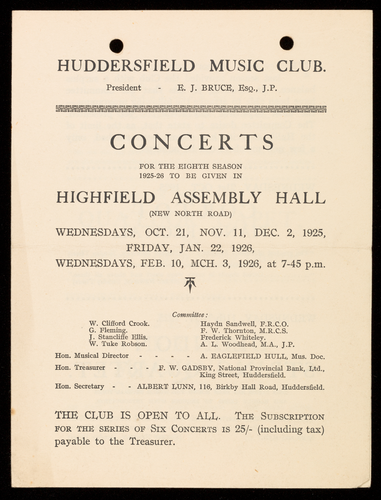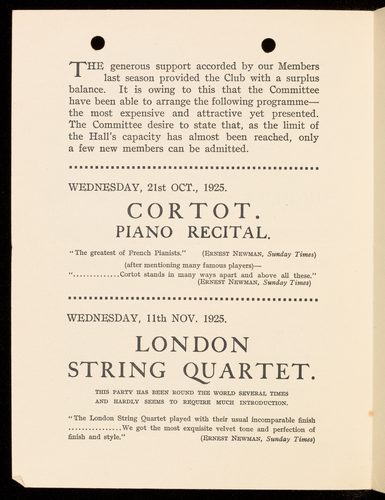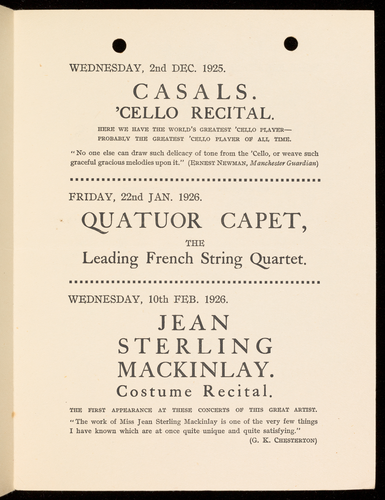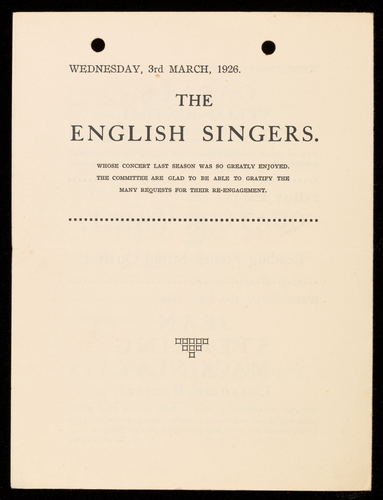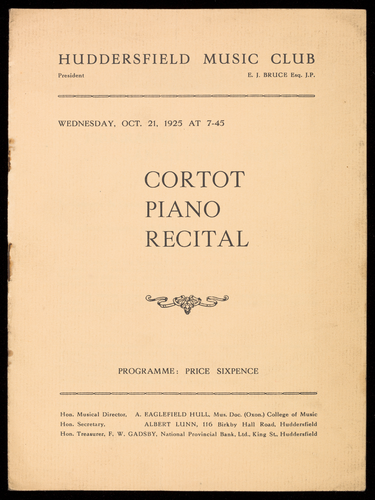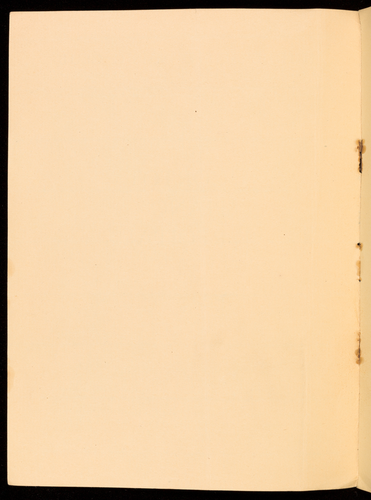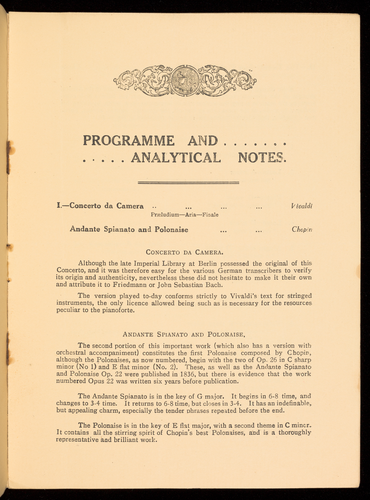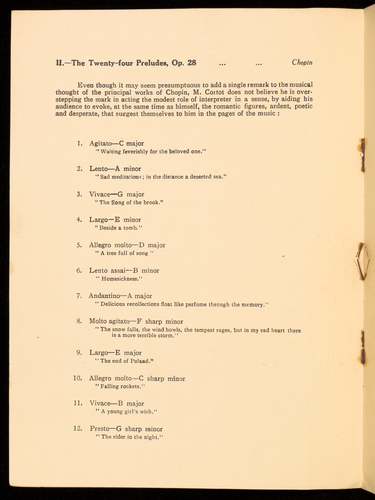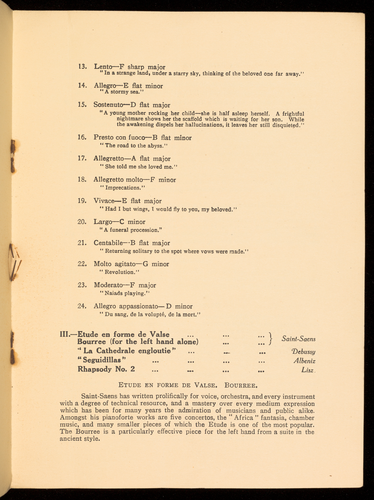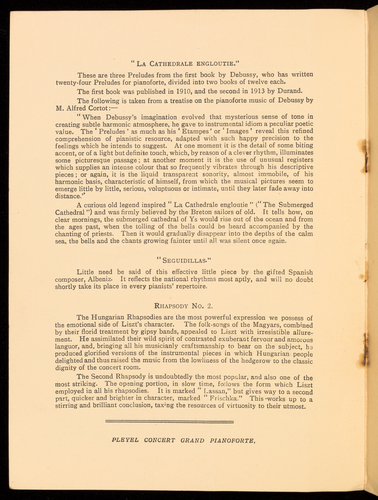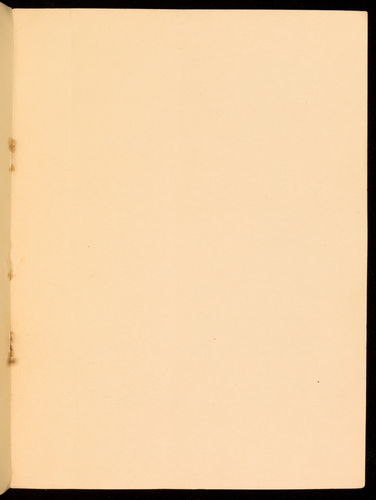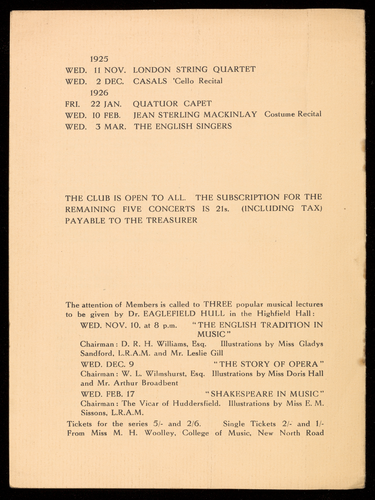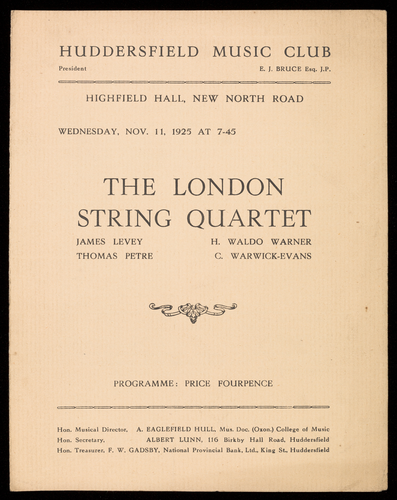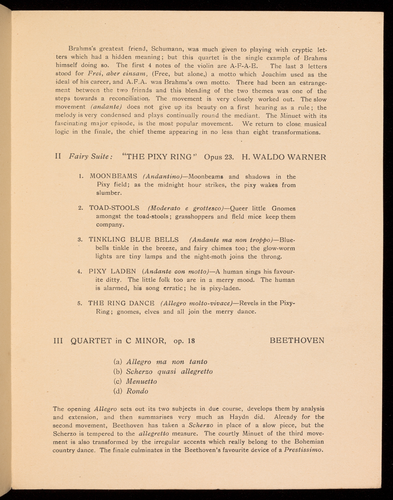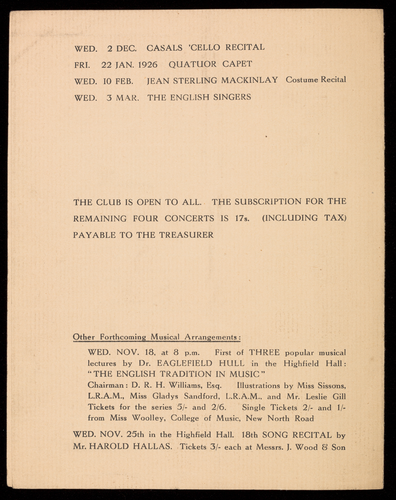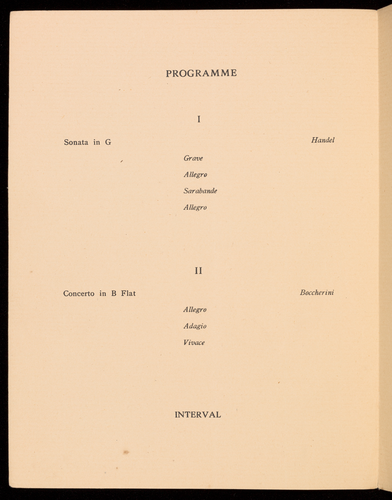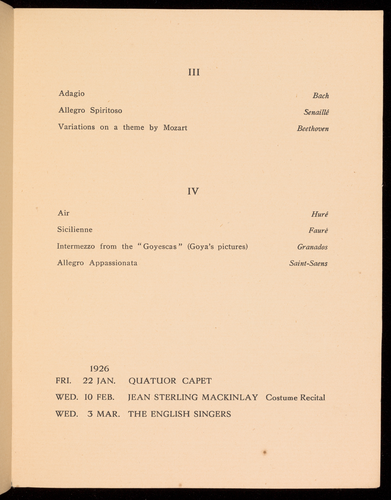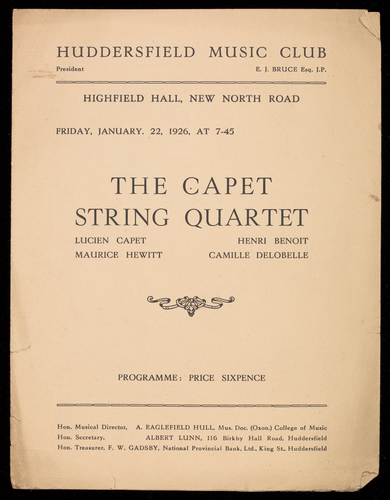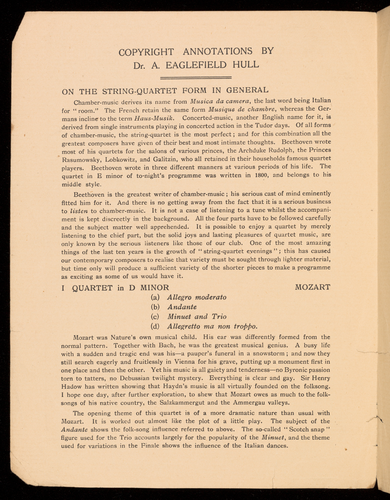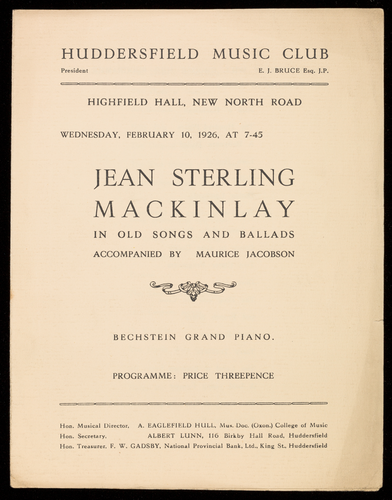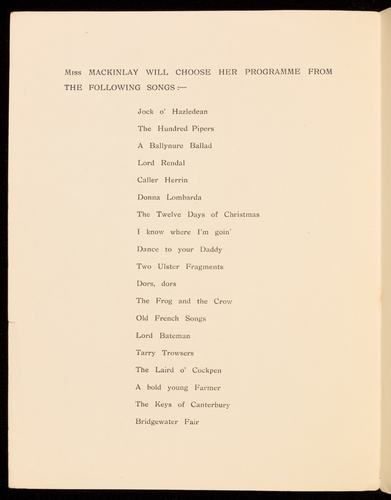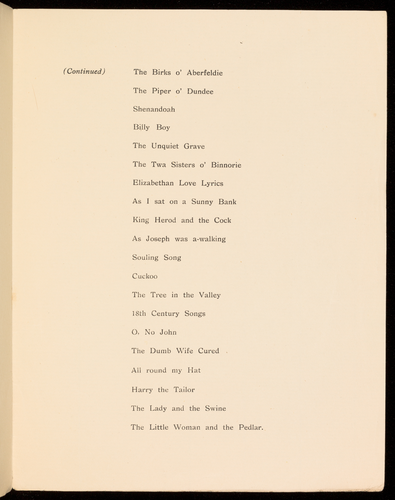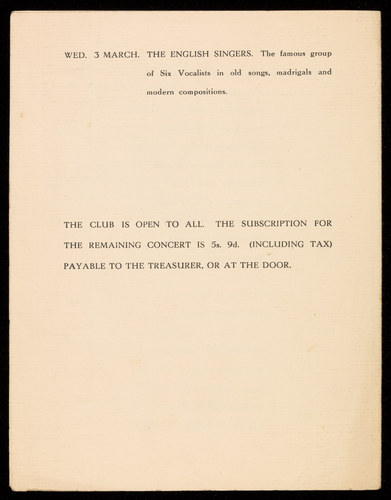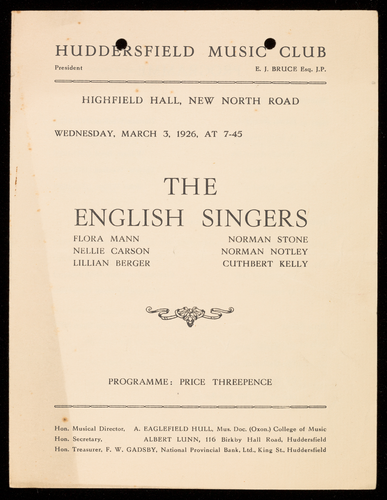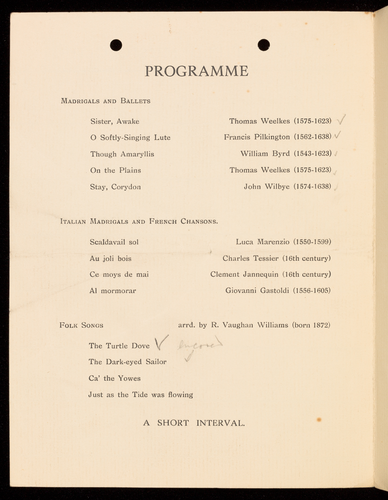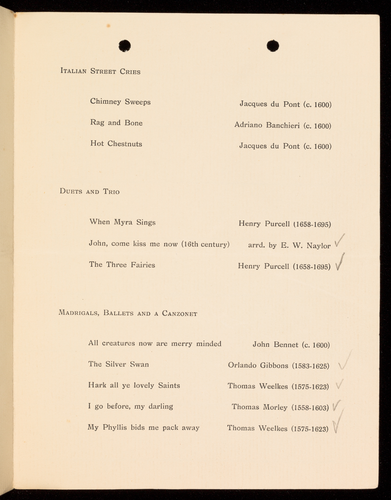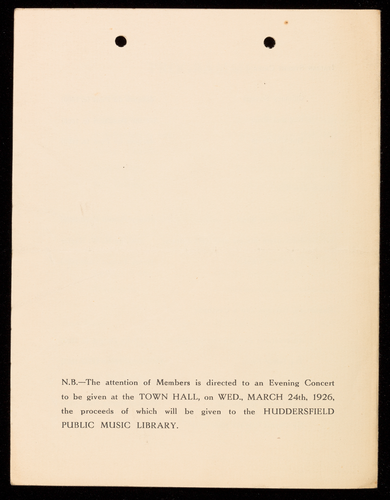Ocr'd Text:
HUDDERSFIELD MUSIC CLUB.
YAYAYAYAYAYAYA
President
5959595!
Hon. Secretary
E. J. BRUCE, Esq., J.P.
W. Clifford Crook.
G. Fleming.
J. Stancliffe Ellis.
W. Tuke Robson.
6969
Hon. Musical Director
Hon. Treasurer
CONCERTS
FOR THE EIGHTH SEASON
1925-26 TO BE GIVEN IN
YAYAYAY
HIGHFIELD ASSEMBLY HALL
(NEW NORTH ROAD)
5959
WEDNESDAYS, OCT. 21, NOV. 11, DEC. 2, 1925,
FRIDAY, JAN. 22, 1926,
WEDNESDAYS, FEB. 10, MCH. 3, 1926, at 7-45 p.m.
*
Committee:
v2v2v2
4545
Haydn Sandwell, F.R.C.O.
F. W. Thornton, M.R.C.S.
Frederick Whiteley.
A. L. Woodhead, M.A., J.P.
A. EAGLEFIELD HULL, Mus. Doc.
F. W. GADSBY, National Provincial Bank, Ltd.,
King Street, Huddersfield.
ALBERT LUNN, 116, Birkby Hall Road, Huddersfield.
THE CLUB IS OPEN TO ALL. THE SUBSCRIPTION
FOR THE SERIES OF SIX CONCERTS IS 25/- (including tax)
payable to the Treasurer.
Ocr'd Text:
THE
HE generous support accorded by our Members
last season provided the Club with a surplus
balance. It is owing to this that the Committee
have been able to arrange the following programme-
the most expensive and attractive yet presented.
The Committee desire to state that, as the limit of
the Hall's capacity has almost been reached, only
a few new members can be admitted.
WEDNESDAY, 21st OCT., 1925.
CORTOT.
PIANO RECITAL.
"The greatest of French Pianists." (ERNEST NEWMAN, Sunday Times)
(after mentioning many famous players)-
. Cortot stands in many ways apart and above all these."
(ERNEST NEWMAN, Sunday Times)
WEDNESDAY, 11th NOV. 1925.
LONDON
STRING QUARTET.
THIS PARTY HAS BEEN ROUND THE WORLD SEVERAL TIMES
AND HARDLY SEEMS TO REQUIRE MUCH INTRODUCTION.
"The London String Quartet played with their usual incomparable finish
. We got the most exquisite velvet tone and perfection of
(ERNEST NEWMAN, Sunday Times)
finish and style."
Ocr'd Text:
WEDNESDAY, 2nd DEC. 1925.
CASALS.
'CELLO RECITAL.
HERE WE HAVE THE WORLD'S GREATEST 'CELLO PLAYER-
PROBABLY THE GREATEST 'CELLO PLAYER OF ALL TIME.
"No one else can draw such delicacy of tone from the 'Cello, or weave such
graceful gracious melodies upon it." (ERNEST NEWMAN, Manchester Guardian)
FRIDAY, 22nd JAN. 1926.
QUATUOR CAPET,
THE
Leading French String Quartet.
WEDNESDAY, 10th FEB. 1926.
JEAN
STERLING
MACKINLAY.
Costume Recital.
THE FIRST APPEARANCE AT THESE CONCERTS OF THIS GREAT ARTIST.
The work of Miss Jean Sterling Mackinlay is one of the very few things
I have known which are at once quite unique and quite satisfying."
(G. K. CHESTERTON)
Ocr'd Text:
WEDNESDAY, 3rd MARCH, 1926.
THE
ENGLISH SINGERS.
WHOSE CONCERT LAST SEASON WAS SO GREATLY ENJOYED.
THE COMMITTEE ARE GLAD TO BE ABLE TO GRATIFY THE
MANY REQUESTS FOR THEIR RE-ENGAGEMENT.
口口口】
미
口】
Д
Ocr'd Text:
HUDDERSFIELD MUSIC CLUB
E. J. BRUCE Esq. J.P.
President
WEDNESDAY, OCT. 21, 1925 AT 7-45
CORTOT
PIANO
RECITAL
PROGRAMME: PRICE SIXPENCE
Hon. Musical Director, A. EAGLEFIELD HULL, Mus. Doc. (Oxon.) College of Music
Hon. Secretary,
ALBERT LUNN, 116 Birk by Hall Road, Huddersfield
Hon. Treasurer, F. W. GADSBY, National Provincial Bank, Ltd., King St., Huddersfield
Ocr'd Text:
PROGRAMME AND.
AND . . . .
.. ANALYTICAL NOTES.
I.-Concerto da Camera
Præludium-Aria-Finale
Andante Spianato and Polonaise
Vivaldi
Chopin
CONCERTO DA CAMERA.
Although the late Imperial Library at Berlin possessed the original of this
Concerto, and it was therefore easy for the various German transcribers to verify
its origin and authenticity, nevertheless these did not hesitate to make it their own
and attribute it to Friedmann or John Sebastian Bach.
The version played to-day conforms strictly to Vivaldi's text for stringed
instruments, the only licence allowed being such as is necessary for the resources
peculiar to the pianoforte.
ANDANTE SPIANATO AND POLONAISE,
The second portion of this important work (which also has a version with
orchestral accompaniment) constitutes the first Polonaise composed by Chopin,
although the Polonaises, as now numbered, begin with the two of Op. 26 in C sharp
minor (No 1) and E flat minor (No. 2). These, as well as the Andante Spianato
and Polonaise Op. 22 were published in 1836, but there is evidence that the work
numbered Opus 22 was written six years before publication.
The Andante Spianato is in the key of G major. It begins in 6-8 time, and
changes to 3-4 time. It returns to 6-8 time, but closes in 3-4. It has an indefinable,
but appealing charm, especially the tender phrases repeated before the end.
The Polonaise is in the key of E flat major, with a second theme in C minor.
It contains all the stirring spirit of Chopin's best Polonaises, and is a thoroughly
representative and brilliant work.
Ocr'd Text:
II.-The Twenty-four Preludes, Op. 28
Even though it may seem presumptuous to add a single remark to the musical
thought of the principal works of Chopin, M. Cortot does not believe he is over-
stepping the mark in acting the modest role of interpreter in a sense, by aiding his
audience to evoke, at the same time as himself, the romantic figures, ardent, poetic
and desperate, that suggest themselves to him in the pages of the music :
1. Agitato-C major
Waiting feverishly for the beloved one."
2. Lento-A minor
"Sad meditations; in the distance a deserted sea."
3. Vivace G major
6.
"The Song of the brook."
4. Largo-E minor
Beside a tomb."
5. Allegro molto-D major
"A tree full of song. "
Lento assai-B minor
Homesickness."
7. Andantino-A major
"Delicious recollections float like perfume through the memory."
8. Molto agitato-F sharp minor
"The snow falls, the wind howls, the tempest rages, but in my sad heart there
is a more terrible storm."
9. Largo-E major
"The end of Poland."
10. Allegro molto-C sharp minor
Falling rockets."
11. Vivace-B major
Chopin
A young girl's wish."
12. Presto-G sharp minor
"The rider in the night."
Ocr'd Text:
11
13. Lento-F sharp major
"In a strange land, under a starry sky, thinking of the beloved one far away."
14. Allegro-E flat minor
"A stormy sea."
15. Sostenuto-D flat major
"A young mother rocking her child-she is half asleep herself. A frightful
nightmare shows her the scaffold which is waiting for her son. While
the awakening dispels her hallucinations, it leaves her still disquieted."
16. Presto con fuoco-B flat minor
"The road to the abyss."
17.
Allegretto-A flat major
"She told me she loved me."
18. Allegretto molto-F minor
"Imprecations."
19. Vivace-E flat major
"Had I but wings, I would fly to you, my beloved."
20. Largo-C minor
A funeral procession."
21. Centabile--B flat major
Returning solitary to the spot where vows were made."
22. Molto agitato-G minor
"Revolution."
23. Moderato--F major
"Naiads playing."
24. Allegro appassionato- D minor
"Du sang, de la volupté, de la mort."
III.-Etude en forme de Valse
Bourree (for the left hand alone)
"La Cathedrale engloutie"
"Seguidillas"
Rhapsody No. 2
::} }Saint-Saens
⠀⠀⠀ ⠀
Debussy
Albeniz
Lisz.
ETUDE EN FORME DE VALSE. BOURREE.
Saint-Saens has written prolifically for voice, orchestra, and every instrument
with a degree of technical resource, and a mastery over every medium expression
which has been for many years the admiration of musicians and public alike.
Amongst his pianoforte works are five concertos, the "Africa " fantasia, chamber
music, and many smaller pieces of which the Etude is one of the most popular.
The Bourree is a particularly effective piece for the left hand from a suite in the
ancient style.
Ocr'd Text:
"LA CATHEDRALE ENGLOUTIE."
These are three Preludes from the first book by Debussy, who has written
twenty-four Preludes for pianoforte, divided into two books of twelve each.
The first book was published in 1910, and the second in 1913 by Durand.
The following is taken from a treatise on the pianoforte music of Debussy by
M. Alfred Cortot:-
6
When Debussy's imagination evolved that mysterious sense of tone in
creating subtle harmonic atmosphere, he gave to instrumental idiom a peculiar poetic
value. The 'Preludes' as much as his Etampes' or 'Images' reveal this refined
comprehension of pianistic resource, adapted with such happy precision to the
feelings which he intends to suggest. At one moment it is the detail of some biting
accent, or of a light but definite touch, which, by reason of a clever rhythm, illuminates
some picturesque passage; at another moment it is the use of unusual registers
which supplies an intense colour that so frequently vibrates through his descriptive
pieces; or again, it is the liquid transparent sonority, almost immobile, of his
harmonic basis, characteristic of himself, from which the musical pictures seem to
emerge little by little, serious, voluptuous or intimate, until they later fade away into
distance."
A curious old legend inspired "La Cathedrale engloutie" ("The Submerged
Cathedral ") and was firmly believed by the Breton sailors of old. It tells how, on
clear mornings, the submerged cathedral of Ys would rise out of the ocean and from
the ages past, when the tolling of the bells could be heard accompanied by the
chanting of priests. Then it would gradually disappear into the depths of the calm
sea, the bells and the chants growing fainter until all was silent once again.
SEGUIDILLAS."
Little need be said of this effective little piece by the gifted Spanish
composer, Albeniz. It reflects the national rhythms most aptly, and will no doubt
shortly take its place in every pianists' repertoire.
RHAPSODY No. 2.
The Hungarian Rhapsodies are the most powerful expression we possess of
the emotional side of Liszt's character. The folk-songs of the Magyars, combined
by their florid treatment by gipsy bands, appealed to Liszt with irresistible allure-
ment. He assimilated their wild spirit of contrasted exuberant fervour and amorous
languor, and, bringing all his musicianly craftsmanship to bear on the subject, he
produced glorified versions of the instrumental pieces in which Hungarian people
delighted and thus raised the music from the lowliness of the hedgerow to the classic
dignity of the concert room.
The Second Rhapsody is undoubtedly the most popular, and also one of the
most striking. The opening portion, in slow time, follows the form which Liszt
employed in all his rhapsodies. It is marked "Lassan," but gives way to a second
part, quicker and brighter in character, marked Frischka." This -works up to a
stirring and brilliant conclusion, taxing the resources of virtuosity to their utmost.
66
PLEYEL CONCERT GRAND PIANOFORTE,
Ocr'd Text:
1925
WED. 11 NOV.
WED. 2 DEC.
1926
LONDON STRING QUARTET
CASALS 'Cello Recital
FRI. 22 JAN.
QUATUOR CAPET
WED. 10 FEB. JEAN STERLING MACKINLAY Costume Recital
WED. 3 MAR. THE ENGLISH SINGERS
THE CLUB IS OPEN TO ALL. THE SUBSCRIPTION FOR THE
REMAINING FIVE CONCERTS IS 21s. (INCLUDING TAX)
PAYABLE TO THE TREASURER
The attention of Members is called to THREE popular musical lectures
to be given by Dr. EAGLEFIELD HULL in the Highfield Hall:
WED. NOV. 10, at 8 p.m.
"THE ENGLISH TRADITION IN
MUSIC "
Illustrations by Miss Gladys
Chairman: D. R. H. Williams, Esq.
Sandford, L.R.A.M. and Mr. Leslie
WED. DEC. 9
Gill
"THE STORY OF OPERA"
Chairman: W. L. Wilmshurst, Esq. Illustrations by Miss Doris Hall
and Mr. Arthur Broadbent
WED. FEB. 17
"SHAKESPEARE IN MUSIC"
Chairman: The Vicar of Huddersfield. Illustrations by Miss E. M.
Sissons, L.R.A.M.
Tickets for the series 5/- and 2/6.
From Miss M. H. Woolley, College
Single Tickets 2/- and 1/-
of Music, New North Road
Ocr'd Text:
HUDDERSFIELD MUSIC CLUB
E. J. BRUCE Esq. J.P.
President
HIGHFIELD HALL, NEW NORTH ROAD
WEDNESDAY, NOV. 11, 1925 AT 7-45
THE LONDON
STRING QUARTET
JAMES LEVEY
THOMAS PETRE
H. WALDO WARNER
C. WARWICK-EVANS
PROGRAMME: PRICE FOURPENCE
Hon. Musical Director, A. EAGLEFIELD HULL, Mus. Doc. (Oxon.) College of Music
Hon. Secretary,
ALBERT LUNN, 116 Birkby Hall Road, Huddersfield
Hon. Treasurer, F. W. GADSBY, National Provincial Bank, Ltd., King St., Huddersfield
Ocr'd Text:
COPYRIGHT ANNOTATIONS BY
Dr. A. EAGLEFIELD HULL
ON THE STRING-QUARTET FORM IN GENERAL
Chamber-music derives its name from Musica da camera, the last word being Italian
for "room." The French retain the same form Musique de chambre, whereas the Ger-
mans incline to the term Haus-Musik. Concerted-music, another English name for it, is
derived from single instruments playing in concerted action in the Tudor days. Of all forms
of chamber-music, the string-quartet is the most perfect; and for this combination all the
greatest composers have given of their best and most intimate; they knew they were writ-
ing, not for mixed concourses of people, but for audiences moderate in size and cultivated
in music.
Beethoven wrote most of his quartets for the salons of various princes, the Archduke
Rudolph, the Princes Rasumowsky, Lobkowitz, and Galitzin, who all retained in their
households famous quartet-players. Beethoven wrote in three different manners at vari-
ous periods of his life. The quartet in C minor of to-night's programme was written in
1800; it consequently belongs to his first style, where he was satisfied to follow in the
clear, refined and courtly manner of his teacher Mozart.
Brahms wrote for more homely but none the less cultivated listeners. He is more
serious even than Beethoven; and his works from first to last makes a more homogeneous
whole. He and Beethoven are the two greatest writers of chamber-music, since their seri-
ous cast of mind eminently fitted them for it. And there is no getting away from the
fact that it is a serious business to listen to chamber-music. It is not a case of listen-
ing to a tune whilst the accompaniment is kept discreetly in the background. All the
four parts have to be followed carefully and the subject matter well apprehended. It
is possible to enjoy a quartet by merely listening to the chief part, but the solid joys
and lasting pleasures of quartet music, are only known by the serious listeners like
those of our club. One of the most amazing things of the last ten years is the growth
of "string-quartet evenings"; this has caused our contemporary composers to realise
that variety must be sought through lighter material. Modern composers are there-
fore writing lighter pieces based on some slight story or programme-sketch. Good
examples of this are to be found in Goossens' "By the Tarn", Speaight's "Shakespearean
Characters," Howell's "Puck's Minuet," Walford Davies' "Peter Pan Suite" and
Warner's "Pixy Ring".
I QUARTET in A MINOR, op. 51; no ii
(a) Allegro
(b) Andante moderato
(c) Quasi minuetto with allegretto interlude
(d) Allegro
BRAHMS
Ocr'd Text:
Brahms's greatest friend, Schumann, was much given to playing with cryptic let-
ters which had a hidden meaning; but this quartet is the single example of Brahms
himself doing so. The first 4 notes of the violin are A-F-A-E. The last 3 letters
stood for Frei, aber einsam, (Free, but alone,) a motto which Joachim used as the
ideal of his career, and A.F.A. was Brahms's own motto. There had been an estrange-
ment between the two friends and this blending of the two themes was one of the
steps towards a reconciliation. The movement is very closely worked out. The slow
movement (andante) does not give up its beauty on a first hearing as a rule; the
melody is very condensed and plays continually round the mediant. The Minuet with its
fascinating major episode, is the most popular movement. We return to close, musical
logic in the finale, the chief theme appearing in no less than eight transformations.
II Fairy Suite: "THE PIXY RING" Opus 23. H. WALDO WARNER
1. MOONBEAMS (Andantino)-Moonbeams and shadows in the
Pixy field; as the midnight hour strikes, the pixy wakes from
slumber.
2. TOAD-STOOLS (Moderato e grottesco)-Queer little Gnomes
amongst the toad-stools; grasshoppers and field mice keep them
company.
3. TINKLING BLUE BELLS (Andante ma non troppo)-Blue-
bells tinkle in the breeze, and fairy chimes too; the glow-worm
lights are tiny lamps and the night-moth joins the throng.
4.
PIXY LADEN (Andante con motto)-A human sings his favour-
ite ditty. The little folk too are in a merry mood. The human
is alarmed, his song erratic; he is pixy-laden.
5. THE RING DANCE (Allegro molto-vivace)-Revels in the Pixy-
Ring; gnomes, elves and all join the merry dance.
III QUARTET in C MINOR, op. 18
(a) Allegro ma non tanto
(b) Scherzo quasi allegretto
(c) Menuetto
(d) Rondo
BEETHOVEN
The opening Allegro sets out its two subjects in due course, develops them by analysis
and extension, and then summarises very much as Haydn did. Already for the
second movement, Beethoven has taken a Scherzo in place of a slow piece, but the
Scherzo is tempered to the allegretto measure. The courtly Minuet of the third move-
ment is also transformed by the irregular accents which really belong to the Bohemian
country dance. The finale culminates in the Beethoven's favourite device of a Prestissimo.
Ocr'd Text:
WED. 2 DEC. CASALS 'CELLO RECITAL
FRI. 22 JAN. 1926 QUATUOR CAPET
WED. IO FEB. JEAN STERLING MACKINLAY Costume Recital
WED. 3 MAR. THE ENGLISH SINGERS
THE CLUB IS OPEN TO ALL. THE SUBSCRIPTION FOR THE
REMAINING FOUR CONCERTS IS 17s. (INCLUDING TAX)
PAYABLE TO THE TREASURER
Other Forthcoming Musical Arrangements :
WED. NOV. 18, at 8 p.m. First of THREE popular musical
lectures by Dr. EAGLEFIELD HULL in the Highfield Hall:
"THE ENGLISH TRADITION IN MUSIC"
Chairman: D. R. H. Williams, Esq. Illustrations by Miss Sissons,
L.R.A.M., Miss Gladys Sandford, L.R.A.M., and Mr. Leslie Gill
Tickets for the series 5/- and 2/6. Single Tickets 2/- and 1/-
from Miss Woolley, College of Music, New North Road
WED. NOV. 25th in the Highfield Hall. 18th SONG RECITAL by
Mr. HAROLD HALLAS. Tickets 3/- each at Messrs. J. Wood & Son
Ocr'd Text:
HUDDERSFIELD MUSIC CLUB
E. J. BRUCE Esq. J.P.
President
HIGHFIELD HALL, NEW NORTH ROAD
WEDNESDAY, DEC. 2, 1925 AT 7-45
PABLO CASALS
VIOLONCELLO
RECITAL
AT THE PIANO:
MR. GEORGE REEVES
PLEYEL GRAND PIANOFORTE
PROGRAMME: PRICE FOURPENCE
Hon. Musical Director, A. EAGLEFIELD HULL, Mus. Doc. (Oxon.) College of Music
Hon. Secretary,
ALBERT LUNN, 116 Birk by Hall Road, Huddersfield
Hon. Treasurer, F. W. GADSBY, National Provincial Bank, Ltd., King St., Huddersfield
Ocr'd Text:
Sonata in G
Concerto in B Flat
PROGRAMME
I
Grave
Allegro
Sarabande
Allegro
II
Allegro
Adagio
Vivace
INTERVAL
Handel
Boccherini
Ocr'd Text:
Adagio
Allegro Spiritoso
Variations on a theme by Mozart
Air
Sicilienne
III
IV
Intermezzo from the Goyescas" (Goya's pictures)
Allegro Appassionatal
Bach
QUATUOR CAPET
Senaillé
Beethoven
Hurê
Fauré
Granados
Saint-Saens
1926
FRI. 22 JAN.
WED. IO FEB. JEAN STERLING MACKINLAY Costume Recital
WED. 3 MAR.
THE ENGLISH SINGERS
Ocr'd Text:
THE CLUB IS OPEN TO ALL. THE SUBSCRIPTION FOR THE
REMAINING THREE CONCERTS IS 13s. (INCLUDING TAX)
PAYABLE TO THE TREASURER
Other Forthcoming Musical Arrangements :
WED. DEC. 9, at 7-30 p.m. Popular Musical Lecture by
Dr. EAGLEFIELD HULL in the Highfield Hall, on "OPERA"
Chairman: W. L. Wilmshurst, Esq. Illustrations by Miss Doris
Hall, Mr. D. R. Oxley, and Mr. H. L. Gill. Tickets 2s. and
and 1s. from Miss Woolley, College of Music, New North Road
TUES. DEC. 15, in the Town Hall GLEE & MADRIGAL CONCERT
at 7-30. Soloists: Miss Muriel Brunskill and Mr. Laurance
Turner.
Tickets Balcony, 4s. 9d.; 1st Area, 3s. 6d.; 2nd
Area, 2s. 4d., from Messrs. J. Wood & Sons.
Ocr'd Text:
HUDDERSFIELD MUSIC CLUB
E. J. BRUCE Esq. J.P.
President
HIGHFIELD HALL, NEW NORTH ROAD
FRIDAY, JANUARY. 22, 1926, AT 7-45
THE CAPET
QUARTET
HENRI BENOIT
CAMILLE DELOBELLE
STRING
LUCIEN CAPET
MAURICE HEWITT
PROGRAMME: PRICE SIXPENCE
Hon. Musical Director, A. EAGLEFIELD HULL, Mus. Doc. (Oxon.) College of Music
Hon. Secretary,
ALBERT LUNN, 116 Birk by Hall Road, Huddersfield
Hon. Treasurer, F. W. GADSBY, National Provincial Bank, Ltd., King St., Huddersfield
Ocr'd Text:
COPYRIGHT ANNOTATIONS BY
Dr. A. EAGLEFIELD HULL
ON THE STRING-QUARTET FORM IN GENERAL
Chamber-music derives its name from Musica da camera, the last word being Italian
for "room." The French retain the same form Musique de chambre, whereas the Ger-
mans incline to the term Haus-Musik. Concerted-music, another English name for it, is
derived from single instruments playing in concerted action in the Tudor days. Of all forms
of chamber-music, the string-quartet is the most perfect; and for this combination all the
greatest composers have given of their best and most intimate thoughts. Beethoven wrote
most of his quartets for the salons of various princes, the Archduke Rudolph, the Princes
Rasumowsky, Lobkowitz, and Galitzin, who all retained in their households famous quartet
players. Beethoven wrote in three different manners at various periods of his life. The
quartet in minor of to-night's programme was written in 1800, and belongs to his
middle style.
Beethoven is the greatest writer of chamber-music; his serious cast of mind eminently
fitted him for it. And there is no getting away from the fact that it is a serious business
to listen to chamber-music. It is not a case of listening to a tune whilst the accompani-
ment is kept discreetly in the background. All the four parts have to be followed carefully
and the subject matter well apprehended. It is possible to enjoy a quartet by merely
listening to the chief part, but the solid joys and lasting pleasures of quartet music, are
only known by the serious listeners like those of our club. One of the most amazing
things of the last ten years is the growth of "string-quartet evenings"; this has caused
our contemporary composers to realise that variety must be sought through lighter material,
but time only will produce a sufficient variety of the shorter pieces to make a programme
as exciting as some of us would have it.
I
QUARTET in D MINOR
(a) Allegro moderato
(b) Andante
(c) Minuet and Trio
(d) Allegretto ma non troppo.
MOZART
Mozart was Nature's own musical child. His ear was differently formed from the
normal pattern. Together with Bach, he was the greatest musical genius. A busy life
with a sudden and tragic end was his-a pauper's funeral in a snowstorm; and now they
still search eagerly and fruitlessly in Vienna for his grave, putting up a monument first in
one place and then the other. Yet his music is all gaiety and tenderness-no Byronic passion
torn to tatters, no Debussian twilight mystery. Everything is clear and gay. Sir Henry
Hadow has written showing that Haydn's music is all virtually founded on the folksong.
I hope one day, after further exploration, to shew that Mozart owes as much to the folk-
songs of his native country, the Salzkammergut and the Ammergau valleys.
The opening theme of this quartet is of a more dramatic nature than usual with
Mozart. It is worked out almost like the plot of a little play. The subject of the
Andante shows the folk-song influence referred to above. The so-called "
Scotch snap"
figure used for the Trio accounts largely for the popularity of the Minuet, and the theme
used for variations in the Finale shows the influence of the Italian dances.
Ocr'd Text:
II QUARTET in E MINOR (No. 2 of 'Rasumowsky set') Op. 59
(a)
(b)
III QUARTET
Allegro
Molto adagio
(c)
(d) Presto
Allegretto and trio
BEETHOVEN
The three quartets written for Count Rasumowsky, Russian Ambassador at the
Viennese Court, are masterpieces of the "middle period." Each one has some movement
founded on a Russian folksong, and the book from which Beethoven took the tunes is well-
known, (Pratsch's collection, published in Moscow, 1795). The quartet in E minor in this
evening's programme begins with a dark passionate opening movement (not unlike the
first movement of the Appassionata piano sonata). Then we have a slow movement, serene
and lovely in its long-drawn melodies; thirdly, a half sad, half playful Allegretto and
Trio; and finally a Presto, full of wild freakish humour and boisterous jollity. The
Russian tune used for the trio of the third movement is the well-known Song of Glori-
fication sung in all Russian churches and on great national occasions. Beethoven however
treats it as a German volkslied, just as he treated the Scotch and Irish songs.
CLAUDE DEBUSSY (1862-1918)
(a) Animé
(b) Assez vit
(c)
Andantino
(d) Trés modéré
Debussy is the real founder of "Impressionism
Impressionism" in music; he is in many ways the
musical parallel of Manet and Monet in painting and Baudelaire, Verlaine and Mallarmé
in poetry. Just as literary impressionism has its roots in the poems of the Middle Ages;
so does Debussy adopt old-world scales, such as that used for the first movement of this
quartet. The listener must give himself up to the "atmosphere" of the piece; it is full
of poetry, suggestions, mysteries; everything-harmony, rhythm, tone-quality-is used for
that end alone. The dance is no ordinary dance; it is the dance of myriads of light
particles. The slow movement is no ordinary elegy; it is a lament for some nymph of
the gloaming. The finale is a summary, as well as a piece in itself.
P.T.O.
Ocr'd Text:
WED. 10 FEB. JEAN STERLING MACKINLAY Costume Recital
WED. 3 MAR. THE ENGLISH SINGERS
THE CLUB IS OPEN TO ALL. THE SUBSCRIPTION FOR THE
REMAINING TWO CONCERTS IS 9s. (INCLUDING TAX)
PAYABLE TO THE TREASURER
SAT. JAN. 23 in the Town Hall. The Arthur W. Kaye Orchestra
Concert at 7 p.m. Soloists: Phillipowsky (Pianist) and Booth Unwin
(Baritone). Full particulars from Messrs. J. Wood & Sons. The
Support of the Club Members is asked for this Concert.
Ocr'd Text:
HUDDERSFIELD MUSIC CLUB
E. J. BRUCE Esq. J.P.
President
HIGHFIELD HALL, NEW NORTH ROAD
WEDNESDAY, FEBRUARY 10, 1926, AT 7-45
JEAN STERLING
MACKINLAY
IN OLD SONGS AND BALLADS
ACCOMPANIED BY MAURICE JACOBSON
S
BECHSTEIN GRAND PIANO.
PROGRAMME: PRICE THREEPENCE
Hon. Musical Director, A. EAGLEFIELD HULL, Mus. Doc. (Oxon.) College of Music
Hon. Secretary,
ALBERT LUNN, 116 Birkby Hall Road, Huddersfield
Hon. Treasurer, F. W. GADSBY, National Provincial Bank, Ltd., King St., Huddersfield
Ocr'd Text:
MISS MACKINLAY WILL CHOOSE HER PROGRAMME FROM
THE FOLLOWING SONGS:-
Jock o' Hazledean
The Hundred Pipers
A Ballynure Ballad
Lord Rendal
Caller Herrin
Donna Lombarda
The Twelve Days of Christmas
I know where I'm goin'
Dance to your Daddy
Two Ulster Fragments
Dors, dors
The Frog and the Crow
Old French Songs
Lord Bateman
Tarry Trowsers
The Laird o' Cockpen
A bold young Farmer
The Keys of Canterbury
Bridgewater Fair
Ocr'd Text:
(Continued)
The Birks o' Aberfeldie
The Piper o' Dundee
Shenandoah
Billy Boy
The Unquiet Grave
The Twa Sisters o' Binnorie
Elizabethan Love Lyrics
As I sat on a Sunny Bank
King Herod and the Cock
As Joseph was a-walking
Souling Song
Cuckoo
The Tree in the Valley
18th Century Songs
O, No John
The Dumb Wife Cured
All round my Hat
Harry the Tailor
The Lady and the Swine
The Little Woman and the Pedlar.
Ocr'd Text:
WED. 3 MARCH. THE ENGLISH SINGERS. The famous group
of Six Vocalists in old songs, madrigals and
modern compositions.
THE CLUB IS OPEN TO ALL. THE SUBSCRIPTION FOR
THE REMAINING CONCERT IS 5s. 9d. (INCLUDING TAX)
PAYABLE TO THE TREASURER, OR AT THE DOOR.
Ocr'd Text:
HUDDERSFIELD MUSIC CLUB
E. J. BRUCE Esq. J.P.
President
HIGHFIELD HALL, NEW NORTH ROAD
WEDNESDAY, MARCH 3, 1926, AT 7-45
THE
ENGLISH SINGERS
FLORA MANN
NELLIE CARSON
LILLIAN BERGER
NORMAN STONE
NORMAN NOTLEY
CUTHBERT KELLY
s
PROGRAMME: PRICE THREEPENCE
Hon. Musical Director, A. EAGLEFIELD HULL, Mus. Doc. (Oxon.) College of Music
Hon. Secretary,
ALBERT LUNN, 116 Birk by Hall Road, Huddersfield
Hon. Treasurer, F. W. GADSBY, National Provincial Bank, Ltd., King St., Huddersfield
Ocr'd Text:
MADRIGALS AND BALLETS
Sister, Awake
O Softly-Singing Lute
Though Amaryllis
On the Plains
PROGRAMME
Stay, Corydon
ITALIAN MADRIGALS AND FRENCH CHANSONS.
Scaldavail sol
Au joli bois
Ce moys de mai
Al mormorar
FOLK SONGS
The Turtle Dove
Thomas Weelkes (1575-1623)✓
Francis Pilkington (1562-1638) ✓✓
William Byrd (1543-1623)
Thomas Weelkes (1575-1623)
John Wilbye (1574-1638)
Luca Marenzio (1550-1599)
Charles Tessier (16th century)
Clement Jannequin (16th century)
Giovanni Gastoldi (1556-1605)
arrd. by R. Vaughan Williams (born 1872)
✓ encore
✓
The Dark-eyed Sailor
Ca' the Yowes
Just as the Tide was flowing
A SHORT INTERVAL.
Ocr'd Text:
ITALIAN STREET CRIES
Chimney Sweeps
Rag and Bone
Hot Chestnuts
DUETS AND TRIO
When Myra Sings
John, come kiss me now (16th century)
The Three Fairies
MADRIGALS, BALLETS AND A CANZONET
All creatures now are merry minded
The Silver Swan
Hark all ye lovely Saints
I go before, my darling
My Phyllis bids me pack away
Jacques du Pont (c. 1600)
Adriano Banchieri (c. 1600)
Jacques du Pont (c. 1600)
Henry Purcell (1658-1695)
arrd. by E. W. Naylor
Henry Purcell (1658-1695)
John Bennet (c. 1600)
Orlando Gibbons (1583-1625)
Thomas Weelkes (1575-1623)
Thomas Morley (1558-1603)
Thomas Weelkes (1575-1623)
✓
V
Ocr'd Text:
N.B.-The attention of Members is directed to an Evening Concert
to be given at the TOWN HALL, on WED., MARCH 24th, 1926,
the proceeds of which will be given to the HUDDERSFIELD
PUBLIC MUSIC LIBRARY.






































 loading...
loading...